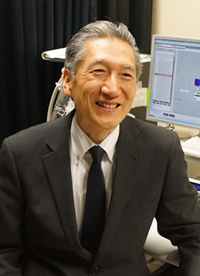 After completing his PhD program in Neurophysiology from Kyoto Prefectural University School of Medicine in 1992, Katsuya Yamada was appointed to Assistant Professor at Akita University. With Dr. Nobuhiko Yamamoto (Osaka University, currently) and Prof. Keisuke Toyama, he developed a cortico-cortical, and cortico-superior collicular slice co-culture systems, which enabled intracellular recordings of in vitro changes in monosynaptic transmission from cortical cells in various layers, later proven to be reflecting developmental changes in NMDA component (Yamamoto, Yamada, Kurotani and Toyama, Neuron 9: 217-228, 1992; Yamada, Yamamoto and Toyama, Eur. J. Neurosci. 12: 3854-3862, 2000). After completing his PhD program in Neurophysiology from Kyoto Prefectural University School of Medicine in 1992, Katsuya Yamada was appointed to Assistant Professor at Akita University. With Dr. Nobuhiko Yamamoto (Osaka University, currently) and Prof. Keisuke Toyama, he developed a cortico-cortical, and cortico-superior collicular slice co-culture systems, which enabled intracellular recordings of in vitro changes in monosynaptic transmission from cortical cells in various layers, later proven to be reflecting developmental changes in NMDA component (Yamamoto, Yamada, Kurotani and Toyama, Neuron 9: 217-228, 1992; Yamada, Yamamoto and Toyama, Eur. J. Neurosci. 12: 3854-3862, 2000).
In 2000, with Prof. Nobuya Inagaki (Kyoto University, currently) and Prof. Hideaki Matsuoka (Tokyo University of Agriculture and Technology), he demonstrated that a fluorescent D-glucose analogue 2-NBDG, which was invented by Matsuoka to see viability of E-coli cells, is taken up into mammalian cells through GLUTs in a quantitative manner (Yamada et al., J. Biol. Chem. 2000). Later on, 2-NBDG has been effectively used in various studies as a standard tool for visualizing glucose uptake (see such as Yamada et al., Nature Protocols 2: 753-762, 2007). To precisely evaluating possible adsorption and non-specific uptake of 2-NBDG, Dr. Yamada developed 2-NBDLG as a control substrate, the first fluorescent analogue of L-glucose available with Dr. Toshihiro Yamamoto (Patents: Yamada et al, EP2325327B1, US8986656B2, JP5682881; Yamamoto, et al., Tetrahedron Lett. 49: 6876-6878, 2008). Unexpectedly, Yamada found with Dr. Ayako Sasaki (PhD student at that time) that 2-NBDLG is taken up into three dimensionally accumulated insulinoma cells showing nuclear heterogeneity, leading to later projects supported by JST, AMED, and Hirosaki University Institutional Research for developing cancer diagnostics.
In late 1990’s, Dr. Yamada started his research with Prof. Inagaki in midbrain nucleus substantia nigra pars reticulata (SNr), the area with the highest expression of ATP-sensitive potassium (KATP) channels in the brain, soon discovering the role of KATP channel during metabolic stress, focusing on its involvement in a suppression mechanism of energy-consuming seizure propagation (Yamada et al, Science 292: 1543-1546, 2001; Yamada and Inagaki, J. Mol. Cell. Cardiol. 38: 945-949, 2005) and gasping (Miyake et al, Eur. J. Neurosci. 25: 2349-2363, 2007). With Dr. Hongjie Yuan (PhD student at that time, Assistant Prof. in Emory Univ. currently), he also discovered that SNr GABAergic neurons sense lowering of glucose (Yuan et al., Neurosci. Lett. 355: 173-176, 2004). These neurons also exhibited multi-minutes oscillation (Yuan et al., Neurosci. Lett. 355: 136-140, 2004), leading to later findings of brain area-specific dopamine receptor expressions in thin astrocytic process and glycine release from astrocytes in response to dopamine collaborating with Dr. Katsuhiro Nagatomo (postdoc initially, then Assistant Prof in Yamada Lab; Nagatomo et al, Front. Neuroanat. 11: 2017) and Dr. Koji Shibasaki (Associate Prof. in Gunma Univ. at that time, Prof. in University of Nagasaki currently. Shibasaki, et al., J. Neurochem. 140: 395-403, 2017), respectively.
In 2005, he moved to Hirosaki city, became an Associate Professor in the Department of Physiology at Hirosaki University Graduate School of Medicine, where he has been continuing with his research since. |